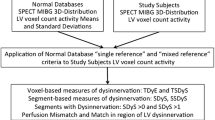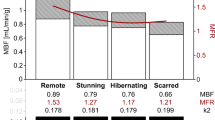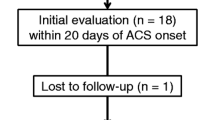Abstract
Purpose
99mTc-glucarate is an infarct-avid imaging agent. However, patients may have mixtures of normal, irreversibly injured, stunned, and hibernating myocardium. The purposes were to determine 99mTc-glucarate uptake and clearance kinetics in these four conditions, and its ability to determine the extent of injury.
Methods
Twenty-two perfused rat hearts were studied: controls (n = 5), stunned (n = 5; 20-min no-flow followed by 5-min reflow), hibernating (n = 6; 120-min low flow at 4 ml/min), and ischemic-reperfused (n = 6; 120-min no-flow followed by reflow). 99mTc-glucarate was then infused. Tracer activity was monitored using a NaI scintillation detector and a multichannel analyzer. Creatine kinase, electron microscopy, and triphenyltetrazolium chloride determined viability.
Results
99mTc-glucarate 10-min myocardial uptake was significantly greater in ischemic-reperfused (2.50 ± 0.09) (cpm, SEM) than in control (1.74 ± 0.07), stunned (1.68 ± 0.11), and hibernating (1.59 ± 0.11) (p < 0.05). Tracer retention curves for ischemic-reperfused were elevated at all time points as compared with the other groups. 99mTc-glucarate 60-min myocardial uptake was significantly greater in ischemic-reperfused (7.60 ± 0.63) than in control (1.98 ± 0.15), stunned (1.79 ± 0.08), and hibernating (2.33 ± 0.15) (p < 0.05). The 60-min well-counted tracer activity ratio of ischemic-reperfused to control was 9:1 and corroborated the NaI detector results. Creatine kinase, triphenyltetrazolium chloride, and electron microscopy all demonstrated significantly greater injury in ischemic-reperfused compared to the other groups. An excellent correlation was observed between viability markers and tracer activity (r = 0.99 triphenyltetrazolium chloride; r = 0.90 creatine kinase).
Conclusion
99mTc-glucarate activity continually and progressively increased in irreversibly injured myocardium. 99mTc-glucarate uptake was strongly correlated with myocardial necrosis as determined by three independent assessments of viability. There were minimal and similar 99mTc-glucarate uptakes in control, stunned, and hibernating myocardium.






Similar content being viewed by others
References
Beanlands RS, Ruddy TD, Bielawski L, Johansen H. Differentiation of myocardial ischemia and necrosis by technetium 99m glucaric acid kinetics. J Nucl Cardiol 1997;4:274–82.
Khaw BA, Nakazawa A, O’Donnell SM, Pak KY, Narula J. Avidity of technetium 99m glucarate for the necrotic myocardium: in vivo and in vitro assessment. J Nucl Cardiol 1997;4:283–90.
Mariani G, Villa G, Rossettin PF, Spallarossa P, Bezante GP, Brunelli C, et al. Detection of acute myocardial infarction by 99mTc-labeled D-glucaric acid imaging in patients with acute chest pain. J Nucl Med 1999;40:1832–9.
Ohtani H, Callahan RJ, Khaw BA, Fishman AJ, Wilkinson RA, Strauss HW. Comparison of technetium-99m-glucarate and thallium-201 for the identification of acute myocardial infarction in rats. J Nucl Med 1992;33:1988–93.
Okada DR, Johnson G, Liu Z, Hocherman SD, Khaw BA, Okada RD. Early detection of infarct in reperfused canine myocardium using 99mTc-glucarate. J Nucl Med 2004;45:655–64.
Johnson 3rd G, Okada CC, Hocherman SD, Liu Z, Hart C, Khaw BA, et al. (99m)Tc-glucarate imaging for the early detection of infarct in partially reperfused canine myocardium. Eur J Nucl Med Mol Imaging 2006;33:319–28.
Johnson LL, Schofield L, Mastrofrancesco P, Donahay T, Farb A, Khaw BA. Technetium-99m glucarate uptake in a swine model of limited flow plus increased demand. J Nucl Cardiol 2000;7:590–8.
Narula J, Petrov A, Pak KY, Lister BC, Khaw BA. Very early noninvasive detection of acute experimental nonreperfused myocardial infarction with 99mTc-labeled glucarate. Circulation 1997;95:1577–84.
Chopra P, Sabherwal U. Histochemical and fluorescent techniques for detection of early myocardial ischemia following experimental coronary artery occlusion: a comparative and quantitative study. Angiology 1988;39:132–40.
Ford WR, Clanachan AS, Hiley CR, Jugdutt BI. Angiotensin II reduces infarct size and has no effect on post-ischaemic contractile dysfunction in isolated rat hearts. Br J Pharmacol 2001;134:38–45.
Rammohan RPA, Haider N, Vural I, Pak CKY, Narula J, Khaw BA. Subnuclear localization of Tc-99m glucarate in necrotic myocardium. J Nucl Med 1996;37:175P.
Khaw BA, Rammohan R. Tc-99m glucaric acid targets the nucleoproteins of acutely necrotic myocardium but cannot target myocardial cell death due to apoptosis. Circulation 1999;100:I-310.
Okada DR, Johnson 3rd G, Liu Z, Hocherman SD, Khaw BA, Pak KY, et al. Myocardial kinetics of Tc-99m glucarate in low flow, hypoxia, and aglycemia. J Nucl Cardiol 2003;10:168–76.
Orlandi C, Crane PD, Edwards DS, Platts SH, Bernard L, Lazewatsky J, et al. Early scintigraphic detection of experimental myocardial infarction in dogs with technetium-99m-glucaric acid. J Nucl Med 1991;32:263–8.
Yaoita H, Fischman AJ, Wilkinson R, Khaw BA, Juweid M, Strauss HW. Distribution of deoxyglucose and technetium-99m-glucarate in the acutely ischemic myocardium. J Nucl Med 1993;34:1303–8.
Liu Z, Barrett HH, Stevenson GD, Kastis GA, Bettan M, Furenlid LR, et al. High-resolution imaging with (99m)Tc-glucarate for assessing myocardial injury in rat heart models exposed to different durations of ischemia with reperfusion. J Nucl Med 2004;45:1251–9.
Acknowledgements
This study was supported in part by grants from the American Heart Association, the William K. Warren Medical Research Institute, and the Anne and Henry Zarrow Foundation. This study is dedicated to the William K. Warren family and the Anne and Henry Zarrow family for their support of medical research, without which these experiments would not have been possible. We are indebted to William Meek Ph.D. for his help in the presentation of the EM data.
Conflicts of interest
Ban-An Khaw is a shareholder in Molecular Targeting Technologies, Inc. The other authors declare that they have no conflict of interest.
Author information
Authors and Affiliations
Corresponding author
Additional information
This work was supported by the American Heart Association, the Anne and Henry Zarrow Foundation, and the William K. Warren Medical Research Foundation.
Rights and permissions
About this article
Cite this article
Okada, D.R., Liu, Z., Johnson, G. et al. 99mTc-glucarate kinetics differentiate normal, stunned, hibernating, and nonviable myocardium in a perfused rat heart model. Eur J Nucl Med Mol Imaging 37, 1909–1917 (2010). https://doi.org/10.1007/s00259-010-1495-0
Received:
Accepted:
Published:
Issue Date:
DOI: https://doi.org/10.1007/s00259-010-1495-0




